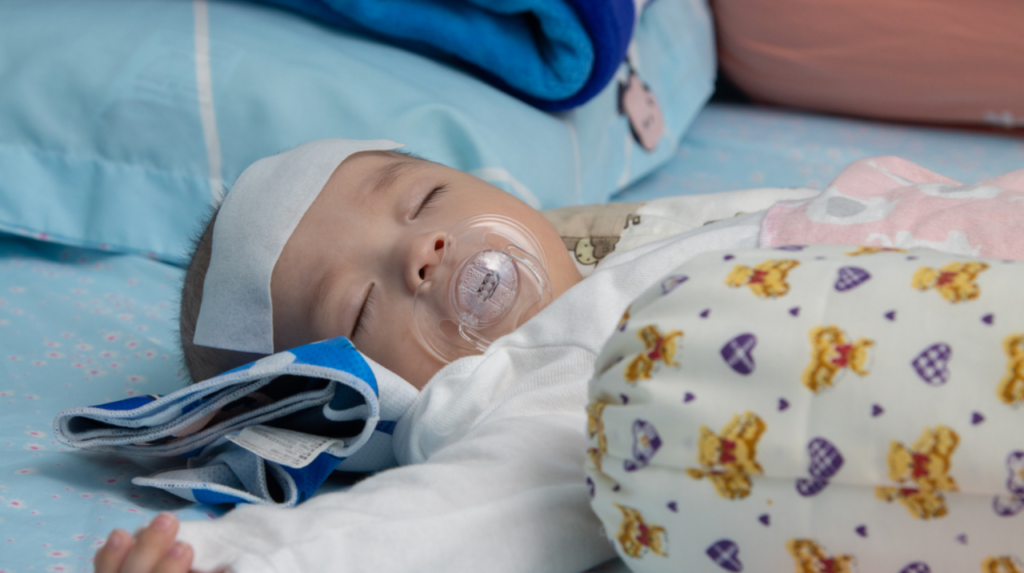What Is Fetal Macrosomia?

Fetal Macrosomia — sometimes called “big baby” — is a condition where a fetus grows exceptionally large before birth. When a baby is very large, vaginal delivery becomes more difficult and risky.
Is Fetal Macrosomia Dangerous?
Most of the time, babies born with fetal macrosomia do not experience any problems. However, a mother who is pregnant with a baby with macrosomia is considered to have a high-risk pregnancy. Both the baby and the mother could have serious, even life-threatening medical complications.
A baby with macrosomia could be born with birth injuries. Possible complications include shoulder dystocia, which happens when the baby’s shoulder gets stuck behind the mother’s pelvic bone during birth, nerve damage, and problems caused by a lack of oxygen.
Risks to the mothers of babies with macrosomia include vaginal tearing, an increased risk of bleeding, and uterine rupture for mothers who have previously had a C-section.
In some cases, babies will need to be delivered by C-section or by a forceps or vacuum-assisted delivery. A C-section delivery is especially likely to be recommended when the baby is estimated to weigh more than 11 pounds, or to weigh more than 9 pounds 15 ounces if the mother is diabetic, or if the mother previously had a baby with shoulder dystocia.
The risks become higher if fetal macrosomia is not properly diagnosed or medically monitored during the mother’s pregnancy, or if there is a problem with the medical care during delivery.
What Exactly Is Fetal Macrosomia?
Fetal macrosomia is diagnosed by the baby’s estimated weight at birth. Some doctors consider babies to have macrosomia if the babies are more than 8 pounds 13 ounces. Other doctors use 9 pounds 15 ounces as the cut-off point. Babies with macrosomia weigh more than approximately 90% of other babies.
Fetal macrosomia is fairly common, affecting about 10 percent of births.
What Causes Fetal Macrosomia?
There are several factors that are known to increase the risk of fetal macrosomia. However, sometimes a baby can have fetal macrosomia even when none of the risk factors are present.
If any of these risk factors are present during pregnancy, the mother should be carefully monitored:
- Diabetes — gestational or Type 1 or Type 2. If the mother’s glucose levels are high, the baby may get more nutrients than needed. Mothers with diabetes are ten times more likely to have macrosomic babies, so doctors should be especially careful to monitor them.
- Weight — obesity and/or a large weight gain during pregnancy. Mothers who were obese before pregnancy and gain more than 20 pounds while pregnant, or mothers who were not overweight before pregnancy and gain more than 35 pounds have a higher risk of fetal macrosomia.
- Pregnancy that lasts longer than 40 weeks.
- The mother previously delivered a baby with macrosomia.
- The mother herself was born with macrosomia.
- Male babies are more likely than female babies to have fetal macrosomia.
How is Fetal Macrosomia Diagnosed?
The diagnosis depends on estimating the baby’s weight. This is more challenging than it may sound because it is not possible to get an exact weight before birth. Doctors have to estimate using these measurements:
- Fundal height — the distance between the mother’s uterus and pubic bone.
- Ultrasound to measure the amount of amniotic fluid. Excess liquid may indicate macrosomia because larger babies may urinate more.
Can Medical Malpractice Cause Fetal Macrosomia?
Although medical malpractice doesn’t cause fetal macrosomia to develop in the first place, the lack of proper medical diagnosis, monitoring, and treatment of fetal macrosomia can lead to dangerous complications that might have been prevented if the doctor had done his or her job correctly.
Doctors and other medical professionals have a legal obligation to provide care that meets a standard of competence. If a doctor who is treating a pregnant woman fails to diagnose macrosomia or gestational diabetes and, because of that, the baby or mother are harmed, then the doctor may have committed medical practice. A surgeon who is negligent during delivery may also be liable for medical malpractice. Medical care given after birth may also be negligent if the newborn and mother aren’t properly examined and tested when needed.
If a baby has macrosomia and the doctor does not diagnose it before birth, that can cause serious problems during delivery. When a baby is properly diagnosed in advance, the doctor can discuss the risks and benefits of a vaginal delivery versus a C-section with the mother. But when a baby with macrosomia is undiagnosed and delivered vaginally, there is a risk the baby may get injured or stuck in the birth canal, which can cause birth injuries that may not have happened with a proper diagnosis.
Proving medical malpractice is a complex area of the law. When a baby with macrosomia or the baby’s mother suffers harm caused by the failure of a doctor, surgeon, other medical professional, or hospital to provide proper care, there may be a case for medical malpractice. If you are in that situation, you should contact an experienced medical malpractice lawyer.
Contact the Medical Malpractice Team at Raynes Lawn Hehmeyer for Help
If you have a child who had fetal macrosomia, and you suspect that a medical professional’s negligence has harmed your child, we would be glad to talk to you. Our lawyers will evaluate your situation. There is no cost or obligation for this consultation.
At the Raynes & Lawn law firm, we treat every client as the important individual that they are. We strongly believe that people who have suffered physically, emotionally, and financially from the mistakes and carelessness of others deserve to get all the help that the law allows.
Our medical malpractice team is honored to have received a Tier 1 rating for our outstanding legal representation. Call us at 1-800-535-1797 or fill out our online contact form to schedule your free consultation.
For the general public: This Blog/Website is made available by the law firm publisher, Raynes & Lawn, for educational purposes. It provides general information and a general understanding of the law but does not provide specific legal advice. By using this site, commenting on posts, or sending inquiries through the site or contact email, you confirm that there is no attorney-client relationship between you and the Blog/Website publisher. The Blog/Website should not be used as a substitute for competent legal advice from a licensed attorney in your jurisdiction.
For attorneys: This Blog/Website is informational in nature and is not a substitute for legal research or a consultation on specific matters pertaining to your clients. Due to the dynamic nature of legal doctrines, what might be accurate one day may be inaccurate the next. As such, the contents of this blog must not be relied upon as a basis for arguments to a court or for your advice to clients without, again, further research or a consultation with our professionals.

